Saving A Giant
First published in Sanctuary Asia,
Vol. 42
No. 2,
February 2022
Ayushi Jain shares with Sanctuary readers how the key to protecting species in legally unprotected areas depends totally on communities, such as the one that chose to champion the survival of the Cantor’s giant softshell turtle.
At the crack of dawn, the sound of another crack drew our attention away from the morning chorus of the birds, to an inconspicuous basket of sand – one of three that contained close to a hundred eggs of an elusive and mysterious being. We were skeptical at first, a faint trail led from the basket centre to its periphery and then disappeared. Maybe a nocturnal visitor, a rodent trying to forage for an easy meal? But there was movement, not inside the basket but in the artificial holding tank we had built around it. A tiny snout broke the surface of the water to take what would be its first breath, that would define the future of the Cantor’s giant softshell turtle.
_C-1700_1643961932.jpg)
The author was able to find a clutch of 40 eggs with the help of local fisherfolk, of which only half a dozen hatched. The wary hatchlings made use of their beautiful camouflaging colours to stay hidden. Photo: Ayushi Jain.
The First Sign
Never did I imagine that my two-year journey towards unveiling the status and attempting to find a critically endangered and understudied freshwater turtle in the wild would result in a discovery that would open a whole new chapter in our story. In January 2020, when I answered the first rescue call from members of the ‘Alert Network’, I was certain I achieved a milestone that nothing could surpass… until I received yet another call, this time from Shashidharan Nair, a villager, fisherman and one of our informants. He hesitantly informed me of an ‘illegal’ sand mining incident, which might have destroyed a nest site of the Bheemanama, the name given by locals in this region of Kerala to the Cantor’s turtle. He took me to the destroyed nest on a promise of anonymity as the sand miners were dangerous. I agreed, for the discovery of this turtle was beyond anything I had hoped for. I rushed to Shashidharan’s house, from where a short walk through an areca nut plantation led us towards a small section of the Payaswini river, a tributary of the Chandragiri river.
I could hear Southern Hill Mynahs shrieking in the background as I took the scene in. The potential nest site was located some 200 m. from a large check dam extending across the entire width of the river. The monsoons were long gone, and a large portion of the river had dried, leaving almost half the dry sand in half the river channel exposed. The Cantor’s giant had found a “suitable” nesting site and the sand miners had found what they knew was ‘cash in hand’. I recalled an indirect sighting at the exact same spot – a turtle’s track marks – about 20 days prior. Was that a female scouting for a suitable nesting spot? Probably! Was it an important stretch to focus our future efforts? Definitely! Shashi showed me 19 “intact” eggs of the 40 reported in the the clutch. The large ovoid, ivory-white eggs suggested they did not belong to any common turtle species. I collected a sample from the destroyed clutch and sent it for DNA analysis. Four weeks later, I got a call confirming that it was indeed a Cantor’s giant softshell turtle that was still breeding in India.
I knew what I had to do next.
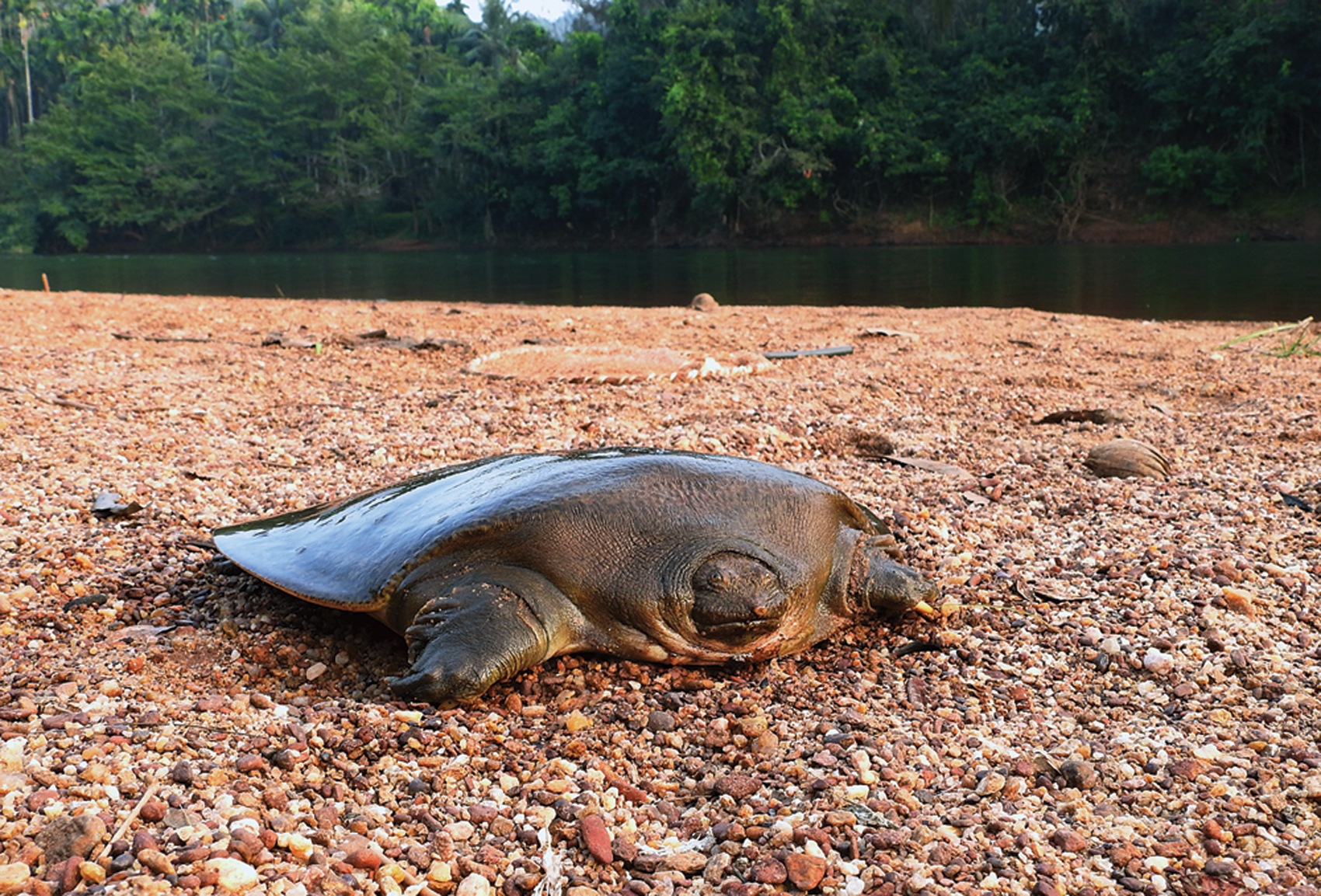
The Cantor’s giant softshell turtle is a large freshwater turtle, distributed in south and east India, large parts of Southeast Asia and parts of China. An IUCN critically endangered species, its threats include loss of habitat, which mainly comprise freshwater bodies, hunting and harvesting for meat. Photo: Ayushi Jain.
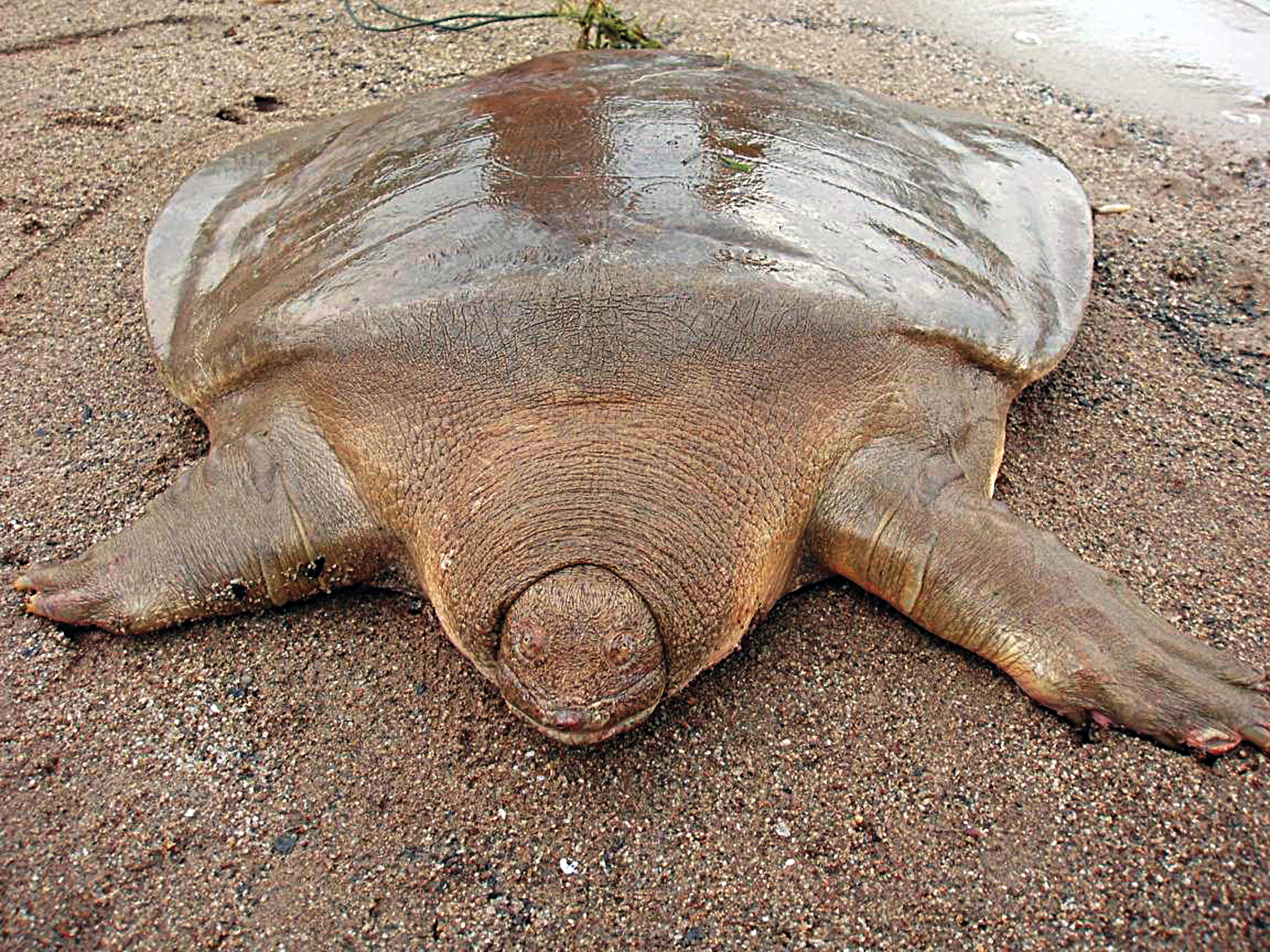 The Cantor’s giant softshell turtle’s muddy brown shell, secretive nature and ability to spend nearly 95 per cent of its time buried in soft sand makes it a difficult subject to study in the wild. Photo: Public domain/Ali Mohammed.
The Cantor’s giant softshell turtle’s muddy brown shell, secretive nature and ability to spend nearly 95 per cent of its time buried in soft sand makes it a difficult subject to study in the wild. Photo: Public domain/Ali Mohammed.
The Cantor’s giant softshell turtle, also known as Asian giant softshell, is distributed widely in South and Southeast Asia. Studies suggest rapid decline throughout its distribution range. Scientists believe that the species is, in fact, locally extinct in parts of Thailand and Vietnam and nearing extinction in Laos. Recent assessment by the IUCN has, therefore, resulted in categorising this turtle as “Critically Endangered”. In India, this species has been recorded from five states, namely, Kerala, Tamil Nadu, Andhra Pradesh, Odisha and West Bengal. However, these sporadic and age-old records again suggest that the species is highly fragmented and on the verge of extinction. Known for its exceptionally large size, the adults can grow over one metre in length and weigh over 100 kg. Despite their large size, they mostly depend on their ability to stay buried under the riverbed for extended periods of time, specialised ambush predation strategies and their secretive nature to conceal and protect themselves from the world above. On land, they rely on their powerful jaws and ‘lightning speed’ strike to protect themselves from predators.
Search Amidst The Pandemic
Over the next few months, I began searching for support from organisations and funders. Just then, the COVID-19 pandemic struck and, like so many wildlife researchers in India, for the next three months I found myself imprisoned in my field base, waiting amidst the grief, anguish, and fear pouring in from all sides, for news of the research support I needed. I eventually heard back from the Mohamed Bin Zayed Species Conservation Fund asking me to go ahead and delve into the nesting ecology of the first-documented breeding population of the Cantor’s giant softshell turtle in India.
More months passed as I waited impatiently to head back to the field. Meanwhile, I kept in contact with my local informants for news on the turtle. In late November 2020, the ferocity of the pandemic waned, and I decided to resume my search for Bheemanama nests. I spent an exhilarating month laying out an extensive plan to locate the nests in and around the Chandragiri river. I installed multiple camera traps on potential nesting sites and monitored them religiously. While conducting our proposed habitat characterisation survey, my team and I meticulously scanned every possible sandy patch along the river, upstream and downstream. On one such afternoon, as an intern and I were filling out the data sheet, while balancing on slippery boulders in the middle of the river, my phone rang: “We have found a palla poovan (yet another vernacular name for Cantor’s giant) nest, can you come?” asked an informant who got my number from a friend. Immediately, I asked Sivuanna, our coracle (a round hand-oared craft) operator, to turn around.
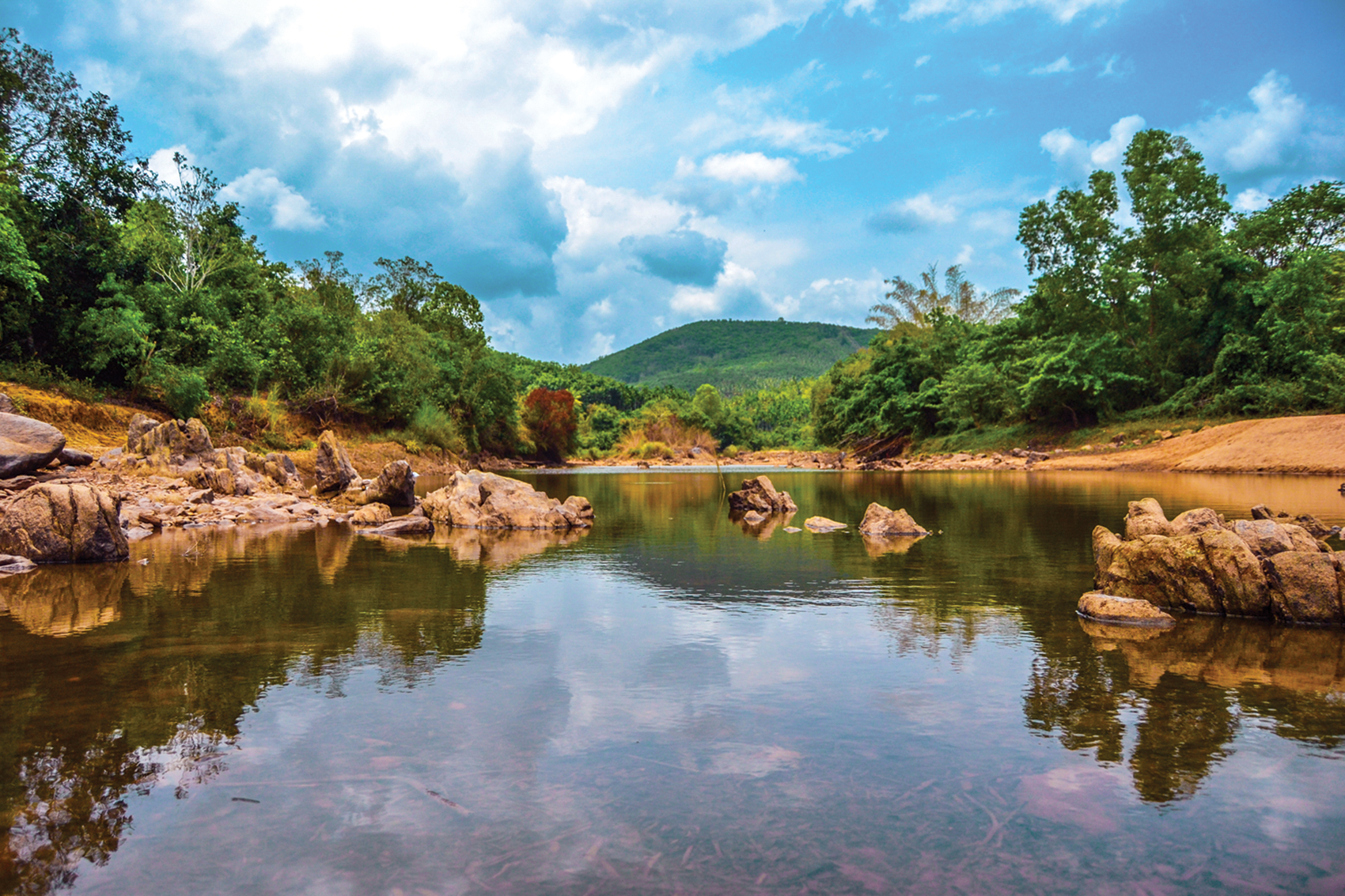 The Chandragiri river habitat suits the cantor’s giant softshell, which, unlike most freshwater turtles, inhabits both freshwater and brackish coastal waters. Photo: Public Domain/Anikatipalla W.
The Chandragiri river habitat suits the cantor’s giant softshell, which, unlike most freshwater turtles, inhabits both freshwater and brackish coastal waters. Photo: Public Domain/Anikatipalla W.
The Payaswini river, a tributary of the west-flowing Chandragiri river, was not known as the home of one of the rarest turtles in India until 2019. Originating from Karnataka, the Chandragiri flows through the northernmost district of Kerala and eventually empties into the Arabian Sea. It supports both freshwater and estuarine habitats, along with a variety of endangered fauna and flora. A nearly perfect habitat for the Cantor’s giant softshell, which, unlike most freshwater turtles, inhabits both freshwater and brackish coastal waters. From supporting agriculture, which forms the major source of income for communities, to providing the only source of drinking water, the Chandragiri river is a life-giving river on which varied biodiversity and human populations are dependent.
It Takes A Village
Abdullah Kunzhi, a local rubber farmer and subsistence fisher, and Madhu Nair, a villager and member of our Alert Network, were waiting for our arrival on a mid-channel bar of the Payaswini river. They had noticed prominent giant turtle track marks on the sandbank. “Ama (turtle) has been visiting this spot for a week, probably looking for a safe nesting spot,” said Abdullah. Local fishers who worked after dark had first noticed the tracks. A large circular depression, dug deeply, filled and then pressed, revealed the turtle’s cleverly chosen nesting site on an open channel bar. The female had chosen an exposed area with fine, coarse gravel forming the majority of the substrate. The fishers had already probed the nest to verify nesting before calling us. This time they decided to protect the nest from harm. However, a new check dam, the largest on the Payaswini river, clearly threatened the survival of the freshly-laid eggs, which would be inundated if the dam gates were tested. I called the local forest officials to inform them of the situation, hopeful of immediate measures to ensure the species survival in our country.
_C-1700_1643962977.jpg)
Post monitoring of the hatchlings over days, the author and her assistant, accompanied by a forest guard released the reptiles at the same spot where their mother had laid the eggs, as they said a silent prayer that they would continue her lineage into the future. Photo: Ayushi Jain.
As an extra precaution, overnight, we decided to create an artificial incubation chamber mimicking the natural nest. The vulnerable nest was carefully opened. Large, round, and soft-shelled eggs deposited in multiple layers in an approximately half-metre deep cradle confirmed it was indeed a giant turtle nest. We then, very carefully, relocated the nest to a secure spot. Based on a recent reading of the species’ reproductive behaviour in a captive-breeding centre in China, I anticipated more clutches in the same location. I asked our informants to keep a watchful eye out. As we had hoped we discovered two more clutches on the same bank within the next two weeks! These nests too were threatened by the same impending danger of being flooded callously at the hands of the unscientifically constructed and unregulated check dam. Clearly, we could not leave the nests to their fate. In the days that followed we were delighted to note the interest in the fate of the turtles from the surrounding villages. Women, men, children from nearby hamlets came visiting to see the “chamber” of eggs, often leaning over each other to catcha glimpse, endowed with chthonic (a place in ancient stories, where the spirits resided) energy; the villagers were as puzzled as they were curious as no one quite understood the significance of this discovery.
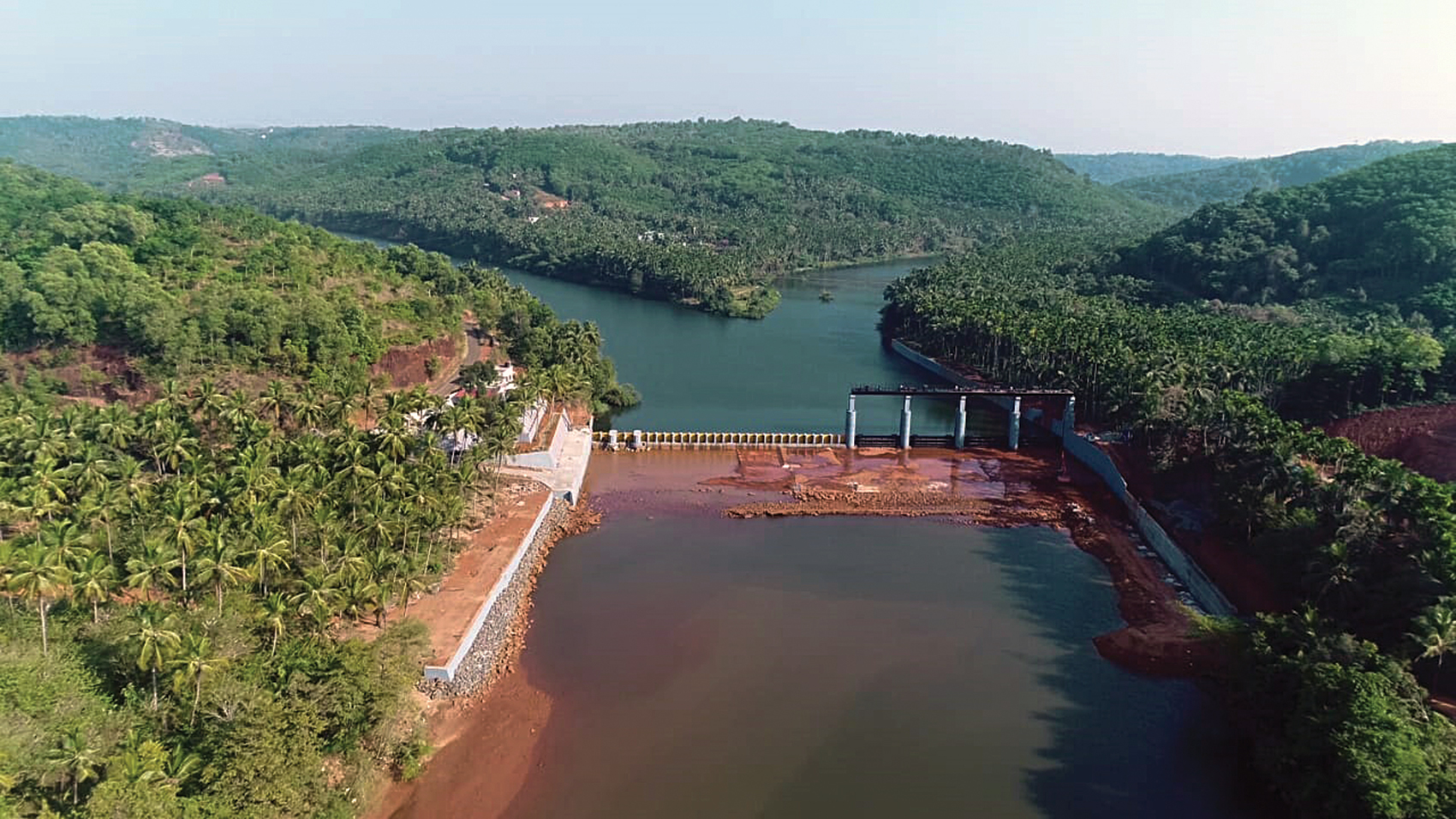 Dams pose a threat to species, including the Cantor’s giant softshell turtle. Even small check dams may fragment habitats and breeding grounds while larger ones divert waters and inundate large parts of the landscape. Photo: Ayushi Jain.
Dams pose a threat to species, including the Cantor’s giant softshell turtle. Even small check dams may fragment habitats and breeding grounds while larger ones divert waters and inundate large parts of the landscape. Photo: Ayushi Jain.
The Cantor’s giant softshell turtle struggles to survive on account of multiple threats to its habitat and hunting for its meat. Among the many threats, construction of check dams poses serious danger. These check dams, while beneficial to the local communities, are often built and operated without any risk assessments to the biodiversity. Along the Chandragiri river, almost a dozen small and large check dams have fragmented the species’ breeding and nesting grounds. They have reduced riverbanks, which are indispensable nesting grounds for the species. The large check dams also act as barriers and hinder the movement of the turtles along the river, which can potentially impact the lifespan of individuals and their capacity to reproduce. Closing the dam channels during the nesting periods floods the already diminished banks, resulting in nest inundations, which can cause irreversible damage to the future of this species.
Against The Odds!
Ninety days! It took us 90 days of testing our patience, our will, and our faith before we savoured success. Day in and day out, we had monitored the nests. From multiple monitoring visits by the Forest Department, to little kids sitting beside the holding tank, everyone kept hoping for that one piece of good news. When the average incubation time went by after two months, we began to lose hope. Maybe the brief flooding of the eggs had already taken its toll. “They will hatch, at least 10 will hatch,’’ said Abdullah, trying to calm my pessimistic nerves. “We will wait for one more month, I am sure they will hatch,” he said. At that moment, I knew I had succeeded. It mattered very little if we had succeeded in this ex-situ hatching effort or not, because the villagers had owned the idea and taken a lead to protect the species and future nests.
In the event, within the next 30 days, as many as six hatchlings had managed to survive the flooding and the untimely rains during their incubation. The flat, round, and soft olive-coloured carapace, with irregular yellow spots and margins, almost makes the hatchlings look like tiny pancakes. Even as two-day-old hatchlings, we observed them flaunting their aggressive strikes and displaying their on-point camouflaging ability. Like the adults, even the slightest disturbance to the water, or even any ‘strange’ sound caused them to quickly take refuge under the sandy substrate. It was a most effective strategy. In the ‘holding tank’, we monitored the hatchlings for a week and noticed that they had started feeding on the tiny fishes and worms that we provided. We could hardly hope for a better sign of good health! Soon they would be ready to return to life in their natural habitat. On the eighth day, hearts in our mouths for their future, we released them on the same bank where their mother had laid her eggs. Within seconds, we lost sight of them as they embarked on their journey that would be beset by a great many challenges. Their fate in the depths they inhabited now was dependent on the health of the river.
Ayushi Jain A conservation biologist and an EDGE fellow with EDGE of Existence Programme, Zoological Society of London, she is working towards studying and protecting the Cantor’s giant softshell turtle in Kerala.
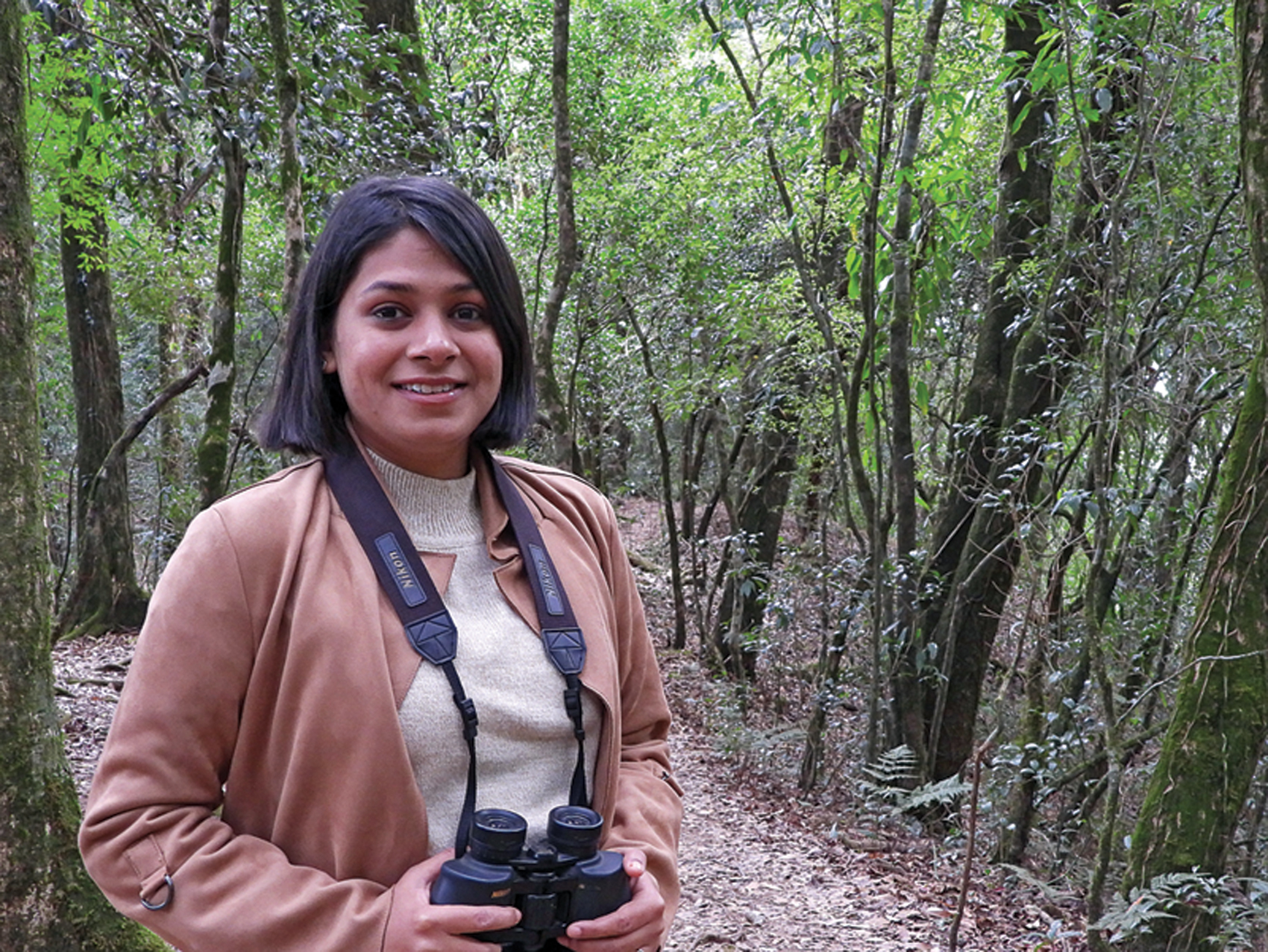 A Call for Action
A Call for Action
Communication, Education and Public awareness (CEPA) is a powerful tool to make any conservation story a success. Going forward, I will heavily rely on this tool in this journey of saving this rare and enigmatic turtle. While we have managed to initiate conversations around conservation for a largely ignored group of freshwater turtles outside of scientific circles, there is still a long and bumpy road ahead. A strategic and community-centric conservation plan and a multi-phased implementation plan in collaboration with decision makers is urgently required. Meanwhile, I will work towards creating a locally led team while also continuing to encourage local communities and forest authorities to work together towards the same goal. These next steps will not only benefit one species but contribute towards the conservation of other threatened softshell turtles in India.
There is a place for every individual in conservation, we just need to find our inspiration.
– Ayushi Jain, Sanctuary Young Naturalist Award, 2021


_C-1700_1643961932.jpg)



_C-1700_1643962977.jpg)

